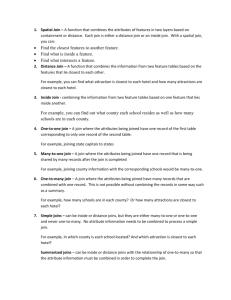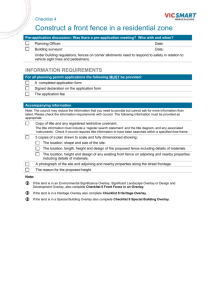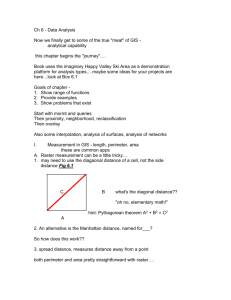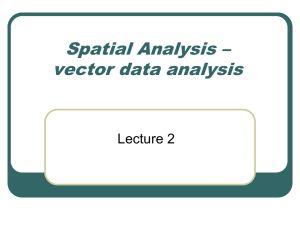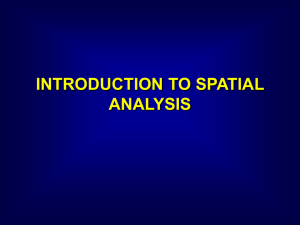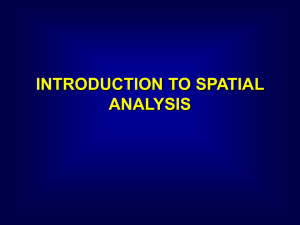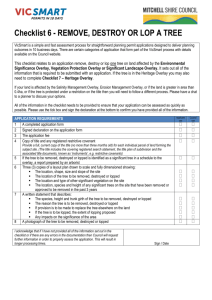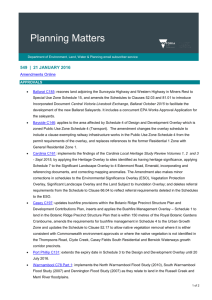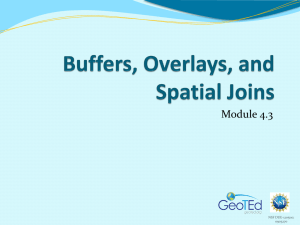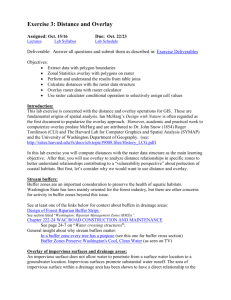(1) (iii) Measurement
advertisement
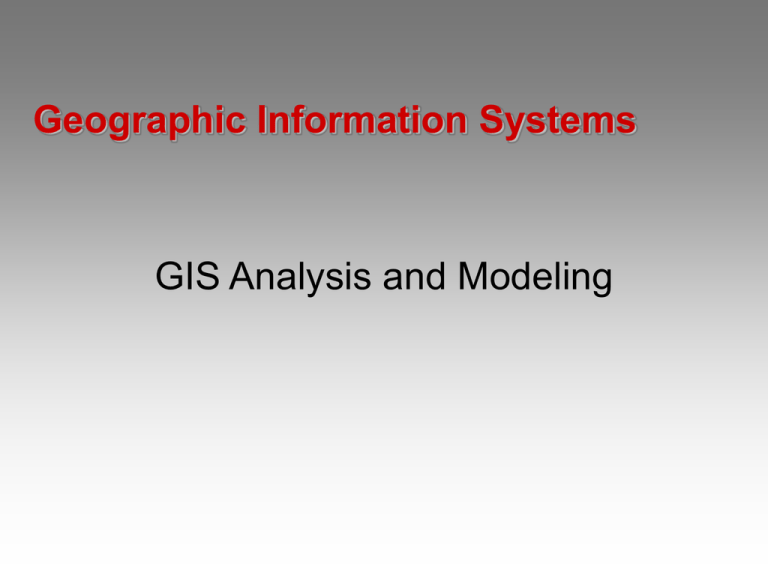
Geographic Information Systems GIS Analysis and Modeling 1. Geographic Analysis Geographic questions: where, when, why, and how The purpose of the analysis is to answer questions about: - what existed at where, when, why, and how - what will happen at where in the future or in other locations 2. Organizing Geographic Data Data layers (coverage etc.) Feature types: points, lines, polygons Objects: geometric or thematic e.g. Development streets - line layer1 streams - line layer2 parcels - polygon layer1 soils - polygon layer2 3. Maintenance of the Spatial Data Format transformation - Spatial data files must be transformed into the data structures and file formats used internally by a GIS software package Geometric transformation - Different data layers are registered to a common coordinate system Conflation 3.(3) Conflation The procedure of reconciling the positions of corresponding features in different data layers (e.g. snapping). 4. Maintenance of Attribute Data Attribute editing - List, add, delete, redefine, etc. Attribute query - Retrieve attributes according to certain criteria 5. Integrated Analysis of Spatial and Attribute Data The power of GIS lies in its ability to analyze spatial and attribute data together Retrieval, classification, and measurements Overlay 5. (1) Retrieval, Classification, and Measurements Retrieval Classification Measurements 5. (1) (i) Retrieval Selective search without modifying the original data (for output) http://www.sdsmt.edu/online-courses/geology/mprice/geo416/lecture9.ppt 5. (1) (ii) Classification Attribute data - cerate a new attribute item based on existing ones Spatial data -spatial features may be aggregated to larger entities e.g. Recode in a raster environment Dissolve in a vector environment Single layer vs. multiple layers (overlay) Classification Raw data Classified data http://www.geog.leeds.ac.uk/courses/level2/geog2750/geog2750_15.ppt 5. (1) (iii) Measurement Distances between points Nearest distances Functional distances Lengths of lines Perimeters and areas of polygons Centroid of an area Area of a profile Volume Shape Narrowest and broadest distances across a polygon Sinuosity of a line 5. (1) (iii) Measurement Distances between Points - Euclidian distance 5. (1) (iii) Measurement Nearest distances The Closest Facility 5. (1) (iii) Measurement Functional Distance Three-minute response time from a fire station, City of Phoenix http://www.esri.com/mapmuseum/mapbook_gallery/volume17/public2.html 5. (1) (iii) Measurement Lengths of lines Perimeters and areas of polygons 5. (1) (iii) Measurement Centroid of an area Used to represent a polygons by a single point Several evaluation methods: mean value, center of the enclosing circle or rectangle, http://www.geoict.net/tgipage/Teaching/UNIT%207--PPT.pdf 5. (1) (iii) Measurement Area of a profile Volume 5. (1) (iii) Measurement Shape - how to measure shape of an area? - a compact shape has a small perimeter for a given area - compare perimeter to the perimeter of a circle of the same area - - shape = perimeter / area Narrowest and broadest distances across a polygon 5. (1) (iii) Measurement Sinuosity of a line - the ratio of reach length to the straight line distance from point A (bottom of reach) to point (top of reach) 5. (2) Overlay Arithmetic overlay Logic overlay Weighting input layers Raster vs. vector overlay 5. (2)(i) Arithmetic Overlay adding layers, subtracting, multiplication, division, etc. Raster Input data layer A Input data layer B Output data layer (2)(i) Arithmetic Overlay Arithmetic5.operation on two data layers using the vector data model Attribute data Spatial data Input data layer A Input data layer B Output data layer 5. (2)(ii) Logic Overlay Finding areas where certain conditions occur Boolean logic Mary Ruvane, UNC –Chapel Hill 5. (2)(iii) Weighting Input Layers Professional experiences Expert votes Empirical or analytical models 5. (2)(iv) Raster vs. Vector Overlay Raster - Every cell is executed, and the overlay result is a new layer Vector - The operation is executed only for areas of interest - New attribute items are created - New layers may be created that carry both the original and new attributes - The operation is generally more complex than raster overlay Raster Overlay Vector Overlay http://www.geoict.net/tgipage/Teaching/UNIT%207--PPT.pdf Readings Chapter 5,6,9,10
